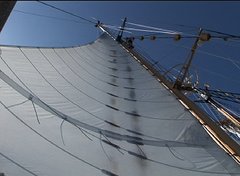
Sails up, and wind pushing us hard- with the motor to help us point in the right directions for our final port of call in Honolulu.
We arrived on a warm day after a wonderful evening where we held a "swizzle" where we played music, shared poetry, stories and emotions about the trip as the wind whipped through the rigging near Lanai. Our time together has come to a close but we're all very thrilled to have safely sailed 3000 nm to a pristine sea, to coral gardens, Palmyra, Christmas Island and the vast Pacific.
 We had an exceptional team this trip aboard ship, led by Sea Scientists (Laura, Katy and Anne) and on deck Captain Phil, and Mates (Rick, Molly and Austin). The galley was made more fun with Sayzie and engineering was tough on this trip- with many small problems but super capable folks handling all aspects of the ship (Tom and Zena). We left with 38 aboard, and came home with 37 (Rob had departed in Palmyra). I particularly enjoyed having one of my mentors aboard ship from Palmyra to Honolulu-- Dr. Joe Bonaventura, who we named the "Director of Morale" Joe, listened to students, helped on projects and baked something almost daily for snacks or meals, and our sea physician Dr. Mike Lipnick (One of my former post-docs who was also inspired early on by Dr. Bonaventura made a wonderful film about the trip shared with all the last night.
We had an exceptional team this trip aboard ship, led by Sea Scientists (Laura, Katy and Anne) and on deck Captain Phil, and Mates (Rick, Molly and Austin). The galley was made more fun with Sayzie and engineering was tough on this trip- with many small problems but super capable folks handling all aspects of the ship (Tom and Zena). We left with 38 aboard, and came home with 37 (Rob had departed in Palmyra). I particularly enjoyed having one of my mentors aboard ship from Palmyra to Honolulu-- Dr. Joe Bonaventura, who we named the "Director of Morale" Joe, listened to students, helped on projects and baked something almost daily for snacks or meals, and our sea physician Dr. Mike Lipnick (One of my former post-docs who was also inspired early on by Dr. Bonaventura made a wonderful film about the trip shared with all the last night. We had this year aboard ship helping on every watch with students- a terrific trio of Stanford graduates teaching assistants (Dane Klinger, Chelsea Wood, Sverre Leroy) and our 3rd mate also hailed from Stanford- the IPER graduate student (Austin Becker). All and all S235 will go in the books as a wonderful trip- to pristine seas at Kingman, that provided vistas and experiences beyond expectations. We learned there were places on Earth that humans had not yet impacted and the power of these places (Kingman Reef & Palmyra Atoll) provided strength and inspiration to a new generation of ocean explorers.
We had this year aboard ship helping on every watch with students- a terrific trio of Stanford graduates teaching assistants (Dane Klinger, Chelsea Wood, Sverre Leroy) and our 3rd mate also hailed from Stanford- the IPER graduate student (Austin Becker). All and all S235 will go in the books as a wonderful trip- to pristine seas at Kingman, that provided vistas and experiences beyond expectations. We learned there were places on Earth that humans had not yet impacted and the power of these places (Kingman Reef & Palmyra Atoll) provided strength and inspiration to a new generation of ocean explorers.


































